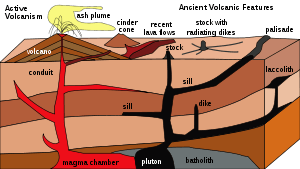Intrusive rock

Intrusive rock forms within Earth's crust from the crystallization of magma. Magma slowly pushes up from deep within the earth into any cracks or spaces it can find, sometimes pushing existing country rock out of the way, a process that can take millions of years. As the rock slowly cools into a solid, the different parts of the magma crystallize into minerals. Many mountain ranges, such as the Sierra Nevada in California, are formed mostly from large granite (or related rock) intrusions.
Intrusions are one of the two ways igneous rock can form; the other is extrusive rock, that is, a volcanic eruption or similar event. Technically speaking, an intrusion is any formation of intrusive igneous rock; rock formed from magma that cools and solidifies within the crust of the planet. In contrast, an extrusion consists of extrusive rock; rock formed above the surface of the crust.
Intrusions vary widely, from mountain-range-sized batholiths to thin veinlike fracture fillings of aplite or pegmatite. When exposed by erosion, these cores called batholiths may occupy huge areas of Earth's surface. Large bodies of magma that solidify underground before they reach the surface of the crust are called plutons. Plutonic rocks form 7% of the Earth's current land surface.[1]
Coarse-grained intrusive igneous rocks that form at depth within the earth are called abyssal while those that form near the surface are called subvolcanic or hypabyssal. Intrusive structures are often classified according to whether or not they are parallel to the bedding planes or foliation of the country rock: if the intrusion is parallel the body is concordant, otherwise it is discordant.
A well-known example of an intrusion is Devils Tower.
Structural types


Intrusions can be classified according to the shape and size of the intrusive body and its relation to the other formations into which it intrudes:
- Batholith: a large irregular discordant intrusion
- Dike: a relatively narrow tabular discordant body, often nearly vertical
- Laccolith: concordant body with roughly flat base and convex top, usually with a feeder pipe below
- Lopolith: concordant body with roughly flat top and a shallow convex base, may have a feeder dike or pipe below
- Phacolith: a concordant lens-shaped pluton that typically occupies the crest of an anticline or trough of a syncline
- Volcanic pipe or volcanic neck: tubular roughly vertical body that may have been a feeder vent for a volcano
- Sill: a relatively thin tabular concordant body intruded along bedding planes
- Stock: a smaller irregular discordant intrusive
- Boss: a small stock
- Chonolith: an irregularly-shaped intrusion with a demonstrable base
Characteristics
Deep-seated intrusions are recognized from the way they have burst through the overlying strata. Ramifying veins result from filled cracks, and the high temperature involved in this process is evident from the altered adjacent country rock. Since heat dissipates slowly and since the rock is under pressure, crystals form and no vitreous rapidly chilled matter is present. As the intrusions have had time to rest before crystallizing, they are not fluidal. Their contained gases have not been able to escape through the thick layer of strata, beneath which they were injected. Such gases form cavities, which can often be observed in these minerals. Such gases have also resulted in many important modifications in the crystallization of the rock. Because their crystals are of approximately equal size these rocks are said to be granular.
There is typically no distinction between a first generation of large well-shaped crystals and a fine-grained ground-mass. The minerals of each have formed in a definite order, and each has had a period of crystallization that may be very distinct or may have coincided with or overlapped the period of formation of some of the other ingredients. Earlier crystals originated at a time when most of the rock was still liquid and are more or less perfect. Later crystals are less regular in shape because they were compelled to occupy the spaces left between the already-formed crystals. The former case is said to be idiomorphic (or automorphic); the latter is xenomorphic. There are also many other characteristics that serve to distinguish the members of these two groups. For example, orthoclase is typically feldspar from granite, while its modifications occur in lavas of similar composition. The same distinction holds for nepheline varieties. Leucite is common in lavas but very rare in plutonic rocks. Muscovite is confined to intrusions. These differences show the influence of the physical conditions under which consolidation takes place.
Intrusive rocks formed at greater depths are called plutonic or abyssal. Some intrusive rocks solidified in fissures as dikes and intrusive sills at a shallow depth beneath the surface and are called subvolcanic or hypabyssal. As might be expected, they show structures intermediate between those of extrusive and plutonic rocks. They are very commonly porphyritic, vitreous, and sometimes even vesicular. In fact, many of them are petrologically indistinguishable from lavas of similar composition.[2]
See also
References
- ↑ Wilkinson, Bruce H.; McElroy, Brandon J.; Kesler, Stephen E.; Peters, Shanan E.; Rothman, Edward D. (2008). "Global geologic maps are tectonic speedometers—Rates of rock cycling from area-age frequencies". Geological Society of America Bulletin. 121: 760–779. doi:10.1130/B26457.1.
- ↑
 One or more of the preceding sentences incorporates text from a publication now in the public domain: Chisholm, Hugh, ed. (1911). "Petrology". Encyclopædia Britannica. 21 (11th ed.). Cambridge University Press. pp. 323–333.
One or more of the preceding sentences incorporates text from a publication now in the public domain: Chisholm, Hugh, ed. (1911). "Petrology". Encyclopædia Britannica. 21 (11th ed.). Cambridge University Press. pp. 323–333.